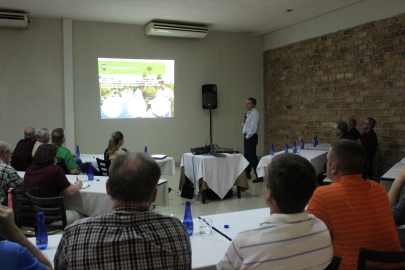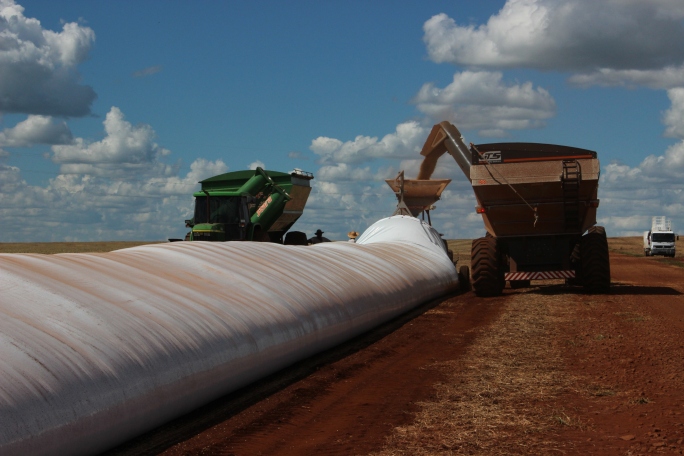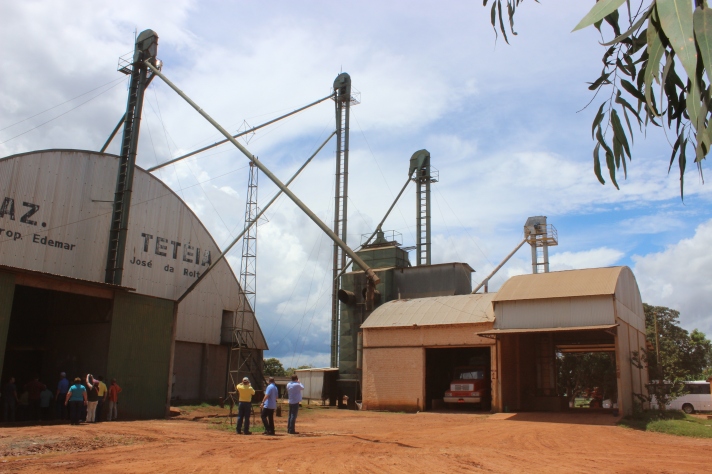Guest Author: Rachael Vonderhaar
Rachael farms with her family in Preble County. She is on the Ohio Small Grains Checkoff Board.
March 15, 2016
As we start off on our 3-5 hour bus drive this morning (the wide time range due to rough infrastructure and heavy truck traffic) to tour Brazilian farms, I realize I have time to review my notes from the last couple of days. Our days have been action packed and long which equals a migraine for Rachael. I am doing much better now as I am able to read & type on the bumpiest roads I have ever been on. I am definitely appreciating the air conditioning on the bus, thankful.
 Yesterday (March 14), we visited with Cid Sanches, Director of Aprosoja, Mato Grosso. Aprosoja is a soybean association formed in 2005 to unify the voices of the farmer to the federal government. Thirteen Brazilian states have Aprosoja Associations. Each state’s agriculture picture is so unique, it’s hard to find a unified national voice across all agriculture.
Yesterday (March 14), we visited with Cid Sanches, Director of Aprosoja, Mato Grosso. Aprosoja is a soybean association formed in 2005 to unify the voices of the farmer to the federal government. Thirteen Brazilian states have Aprosoja Associations. Each state’s agriculture picture is so unique, it’s hard to find a unified national voice across all agriculture.
Soybeans are first crop here and corn is a second crop, which means, corn is planted behind the harvest of the soybeans. The growing season is long enough to raise and harvest two crops in one season in the same field following each other. Sometimes cotton is grown as the second, or double, crop.
Cid mentioned several goals Aprosoja is working on for the farmers:
- Communication with the federal government
- Labor Laws
- Production Loss
- Regulations
- International policy
- Land use
- Biodiesel
- Infrastructure/ Transportation
- Educating Farmers
- Agronomy
- Farm Safety
- Profitability
- Coordinating Research
Comparatively to the U.S. Ag landscape, Approsoja is doing the work of our Checkoffs, The Ohio State University Extension, & farm associations/organizations like Ohio Corn & Wheat Growers Association. Brazil has 22% of the worlds crop producing land and 12% of the worlds water, which is a lot of financial opportunity. However, the lack of infrastructure holds the Brazilian agriculture sector from reaching its full potential. Several groups, including the Chinese government, have tried to work with the Brazilian government to build railroad infrastructure to get crops to the ports more efficiently, but there is a current law that prevent any roads or rail from crossing state lines unless owned by the government. Brazil has partnered on public private partnerships in the past, but only when the government owns the final product. The Brazilian government has allowed several entities to explore rail construction options, but no progress has taken place. Conservation is also a big part of the conversation as to why the infrastructure is a challenge.
My take-aways:
- Aprosoja has a lot of work to do with such a large list of topics.
- I have a lot of respect for the Brazilian farmers and the patience they have for dealing with lack of infrastructure and government struggle (there were large protests/demonstrations that took place on Sunday demanding impeachment of the current President).
Marco Reis joined us this evening for a presentation and dinner. Marco represents Alianca De Terra, a not-for-profit committed to working hand-in-hand with the Brazilian farmer and sustainability in three specific areas:
- Environment
- Conservation
- Fire Prevention / Fire Brigade
- Soil Health
- Social – native & indigenous people
- Sharing cattle genetics (Texas Christian University Project)
- Sharing agricultural practices
- Production
- Gathering information for research
- Profitability
- Traceability
 Marco shared the story of John Carter moving to Brazil and starting his soybean farm in the wilderness of northern Mato Grosso. I am not sure I have the grit to make that kind of leap in life, but what an exciting adventure. The Brazilian government did a social outreach program giving 600 families 100 hectares each so they may start farming. Alianca De Terra helps to provide education about conservation to the new farmers. They also work with RTRS (Round Table on Responsible Soy) which represents: the soy value chain, responsible soy production, and works with the European market on negotiations. Alianca De Terra is working hard to educate on the understanding the value of conservation & the long term value of “producing right”. Brazil has strict restrictions on clearing of land for agriculture and the value of conservation. Alianca De Terra helps to make sure all farmers are using good land stewardship practices. The most interesting detail of the night was that small scale ag in Brazil is in the most need for education on good stewardship practices.
Marco shared the story of John Carter moving to Brazil and starting his soybean farm in the wilderness of northern Mato Grosso. I am not sure I have the grit to make that kind of leap in life, but what an exciting adventure. The Brazilian government did a social outreach program giving 600 families 100 hectares each so they may start farming. Alianca De Terra helps to provide education about conservation to the new farmers. They also work with RTRS (Round Table on Responsible Soy) which represents: the soy value chain, responsible soy production, and works with the European market on negotiations. Alianca De Terra is working hard to educate on the understanding the value of conservation & the long term value of “producing right”. Brazil has strict restrictions on clearing of land for agriculture and the value of conservation. Alianca De Terra helps to make sure all farmers are using good land stewardship practices. The most interesting detail of the night was that small scale ag in Brazil is in the most need for education on good stewardship practices.
Our presentation was followed with a buffet meal at a Brazilian steakhouse and a lot of good conversation and debate.
I am thankful to farm in United States. I am thankful to farm in Ohio. I am thankful for our infrastructure, and now even more driven to be vocal for maintaining it. I am thankful for extension services, checkoffs, & commodity associations who divide and conquer agriculture obstacles we face everyday. I am thankful for my opportunity to learn first-hand about Brazilian agriculture after reading about it for years in grain market reports.
 Constructed in 1984, the dam was built to be 18 times larger than the Hoover dam and the reservoir’s size is equal to the area of Chicago. Itaipu Dam is a bi-national enterprise undertaken by Brazil and Paraguay on the Paraná River, along the border between both countries. The power plant runs under the Itaipu treaty, a geopolitical compromise which created a company that is neither a state-controlled company nor a corporation. Everything, including where the staffers are from, is split evenly between the two countries.
Constructed in 1984, the dam was built to be 18 times larger than the Hoover dam and the reservoir’s size is equal to the area of Chicago. Itaipu Dam is a bi-national enterprise undertaken by Brazil and Paraguay on the Paraná River, along the border between both countries. The power plant runs under the Itaipu treaty, a geopolitical compromise which created a company that is neither a state-controlled company nor a corporation. Everything, including where the staffers are from, is split evenly between the two countries.



 food industry by starting with members who grow crops and members who use those crops to feed livestock. Copagril is a partner of a meat processing facility that harvests the members’ livestock which is then sold at the cooperative’s four supermarkets. They have 15 grain elevators located on the southern region of Mato Grosso do Sul and the northeastern of Paraná state, with a total capacity for the storage of 276,000 tons.
food industry by starting with members who grow crops and members who use those crops to feed livestock. Copagril is a partner of a meat processing facility that harvests the members’ livestock which is then sold at the cooperative’s four supermarkets. They have 15 grain elevators located on the southern region of Mato Grosso do Sul and the northeastern of Paraná state, with a total capacity for the storage of 276,000 tons.
 Our visit was to see the work being done to integrate cattle grazing into soybean-corn-grass rotation. Their main objectives included keeping the ground covered with vegetation year round, providing fodder for cattle in dry months when all the other grass is gone, and continually improving soil quality. This program is designated as a priority by the government and is well-staffed and funded.
Our visit was to see the work being done to integrate cattle grazing into soybean-corn-grass rotation. Their main objectives included keeping the ground covered with vegetation year round, providing fodder for cattle in dry months when all the other grass is gone, and continually improving soil quality. This program is designated as a priority by the government and is well-staffed and funded. The cane is cut, leaves removed, cut into short pieces and loaded into a tip cart and then loaded into tandem semi carts to be taken to the mill. Pulled by semi trucks that can be moved field to field, everyone has the government-required toilets and break room on the field. Water trucks run constantly to keep the dust in check.
The cane is cut, leaves removed, cut into short pieces and loaded into a tip cart and then loaded into tandem semi carts to be taken to the mill. Pulled by semi trucks that can be moved field to field, everyone has the government-required toilets and break room on the field. Water trucks run constantly to keep the dust in check.
 Our first visit today was to FAMASUL, the Agriculture Federation of Mato Grosso do Sul. FAMASUL could be comparable to a state farm bureau as they represent the interests of farmers on general issues. Barrio Cachoeirra II of FAMASUL gave us a presentation about the competitiveness of Brazil’s agribusiness. We filtered through charts and graphs about each sectors of Brazil’s agricultural industry, learning first-hand about how the agribusiness industry supports Brazil through fairly stable, rapid growth in many areas of agriculture.
Our first visit today was to FAMASUL, the Agriculture Federation of Mato Grosso do Sul. FAMASUL could be comparable to a state farm bureau as they represent the interests of farmers on general issues. Barrio Cachoeirra II of FAMASUL gave us a presentation about the competitiveness of Brazil’s agribusiness. We filtered through charts and graphs about each sectors of Brazil’s agricultural industry, learning first-hand about how the agribusiness industry supports Brazil through fairly stable, rapid growth in many areas of agriculture.


 Picture yourself driving from Cincinnatti to Cleveland and finding nothing but gently rolling ground, fantastic soils, year around warmth, and acres upon acres of corn, soybeans, and cotton. Keep in mind you are on a two lane road and haven’t spotted a single house. Now imagine that those crops have the potential to increase yield by a factor up to 2x at any given moment.
Picture yourself driving from Cincinnatti to Cleveland and finding nothing but gently rolling ground, fantastic soils, year around warmth, and acres upon acres of corn, soybeans, and cotton. Keep in mind you are on a two lane road and haven’t spotted a single house. Now imagine that those crops have the potential to increase yield by a factor up to 2x at any given moment.
 In this area of Brazil, corn is usually the third most profitable crop. Soybeans are always the most profitable, followed by cotton. Wheat is not grown here but researchers are working to develop varieties suitable for this area. Just like Ohio, Brazil seems to be very committed to a crop rotation to help break up disease cycles and improve soil health. YieldIng 90-100 bu/ac, corn is always the second crop and therefore has the less ideal growing weather. Corn is here to stay but it currently doesn’t get the bulk of their attention and investment. But even with low yields, the shear number of acres makes Brazil a real competitor for corn.
In this area of Brazil, corn is usually the third most profitable crop. Soybeans are always the most profitable, followed by cotton. Wheat is not grown here but researchers are working to develop varieties suitable for this area. Just like Ohio, Brazil seems to be very committed to a crop rotation to help break up disease cycles and improve soil health. YieldIng 90-100 bu/ac, corn is always the second crop and therefore has the less ideal growing weather. Corn is here to stay but it currently doesn’t get the bulk of their attention and investment. But even with low yields, the shear number of acres makes Brazil a real competitor for corn. 3,500 ac farm is in Primavera do Leste. It’s not the largest farm we’ll see during our mission, but it still has a full-time staff of 8 with more added during the busy seasons. Father, daughter and son manage the farm, but they all live in town. The staff lives on the farm with their families in individual housing and singles in group housing. One 18-inch row planter is used for beans and corn. Laser straight rows indicate auto steering has arrived. It wasn’t common a couple years ago.
3,500 ac farm is in Primavera do Leste. It’s not the largest farm we’ll see during our mission, but it still has a full-time staff of 8 with more added during the busy seasons. Father, daughter and son manage the farm, but they all live in town. The staff lives on the farm with their families in individual housing and singles in group housing. One 18-inch row planter is used for beans and corn. Laser straight rows indicate auto steering has arrived. It wasn’t common a couple years ago.
 Yesterday (March 14), we visited with Cid Sanches, Director of Aprosoja, Mato Grosso. Aprosoja is a soybean association formed in 2005 to unify the voices of the farmer to the federal government. Thirteen Brazilian states have Aprosoja Associations. Each state’s agriculture picture is so unique, it’s hard to find a unified national voice across all agriculture.
Yesterday (March 14), we visited with Cid Sanches, Director of Aprosoja, Mato Grosso. Aprosoja is a soybean association formed in 2005 to unify the voices of the farmer to the federal government. Thirteen Brazilian states have Aprosoja Associations. Each state’s agriculture picture is so unique, it’s hard to find a unified national voice across all agriculture.
 Marco shared the story of John Carter moving to Brazil and starting his soybean farm in the wilderness of northern Mato Grosso. I am not sure I have the grit to make that kind of leap in life, but what an exciting adventure. The Brazilian government did a social outreach program giving 600 families 100 hectares each so they may start farming. Alianca De Terra helps to provide education about conservation to the new farmers. They also work with RTRS (Round Table on Responsible Soy) which represents: the soy value chain, responsible soy production, and works with the European market on negotiations. Alianca De Terra is working hard to educate on the understanding the value of conservation & the long term value of “producing right”. Brazil has strict restrictions on clearing of land for agriculture and the value of conservation. Alianca De Terra helps to make sure all farmers are using good land stewardship practices. The most interesting detail of the night was that small scale ag in Brazil is in the most need for education on good stewardship practices.
Marco shared the story of John Carter moving to Brazil and starting his soybean farm in the wilderness of northern Mato Grosso. I am not sure I have the grit to make that kind of leap in life, but what an exciting adventure. The Brazilian government did a social outreach program giving 600 families 100 hectares each so they may start farming. Alianca De Terra helps to provide education about conservation to the new farmers. They also work with RTRS (Round Table on Responsible Soy) which represents: the soy value chain, responsible soy production, and works with the European market on negotiations. Alianca De Terra is working hard to educate on the understanding the value of conservation & the long term value of “producing right”. Brazil has strict restrictions on clearing of land for agriculture and the value of conservation. Alianca De Terra helps to make sure all farmers are using good land stewardship practices. The most interesting detail of the night was that small scale ag in Brazil is in the most need for education on good stewardship practices.



 On March 11, Ohio farmers will embark on a 12-day market study mission of Brazil, a major competitor of international sales to the U.S. The purpose of this mission is a gain a better understand of Brazil’s role in the worldwide market of agriculture.
On March 11, Ohio farmers will embark on a 12-day market study mission of Brazil, a major competitor of international sales to the U.S. The purpose of this mission is a gain a better understand of Brazil’s role in the worldwide market of agriculture.